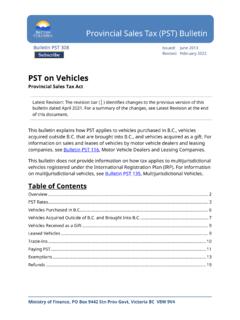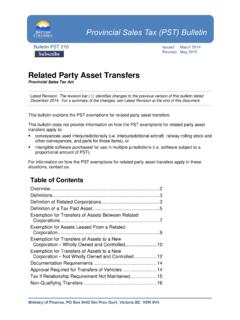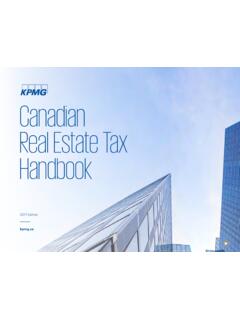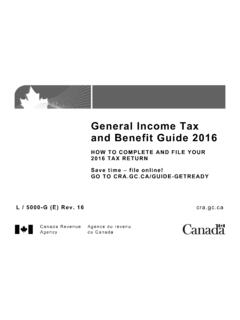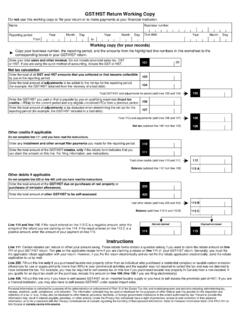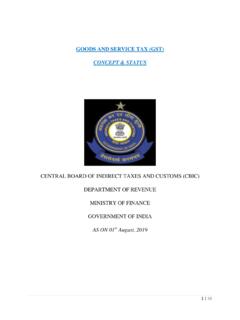Transcription of Intrastat guide 2018 Deloitte Global Tax Center (Europe)
1 Intrastat guide 2018 Deloitte Global Tax Center (Europe)02 Deloitte Intrastat guide 2018 Table of contents Introduction 03 Intrastat 04 Austria 09 Belgium 12 Bulgaria 15 Croatia 17Cy pr us
2 19 Czech Republic 21 Denmark 23 Estonia 25 Finland 28 Germany 34 Greece 36 Hungary 38 Ireland 40 Italy 42 Latvia 45 Lithuania 47 Luxembourg 50 Malta 52 Netherlands 54 Poland 56 Portugal
3 59 Romania 62 Slovak Republic 64 Slovenia 66 Spain 68 Sweden 70 United Kingdom 72 Appendix I Intrastat thresholds 7403 Deloitte Intrastat guide 2018 IntroductionA business engaged in international trade across the European Union may be subject to reporting requirements in addition to the requirements to file periodic VAT returns and/or European Sales Listings (ESL).
4 Intrastat isa statistical declaration that must be submitted by certain traders, which measures the movement of goods between the EU member states. Although the Intrastat filing obligation is based on an EU Regulation, there are some differences in how the member states have implemented the rules. As a result, affected traders needto understand the rules for each member state. The Intrastat guide 2018 sets out the filing requirements and procedures for all 28 EU member you have any questions or comments, please contact one of the following individuals:Olivier Hody Sandeep Shinde Ameen Abbas A Partner Assistant Manager Senior 32 2 600 66 49 + 32 2 600 65 89 +91 40 6747 7803Or contact our general contact/email address preparation, review and coordination of the 2018 edition of the Intrastat guide was carried out by Deloitte Global Tax Center (Europe), with the assistance of the Deloitte publication contains general information only, and none of Deloitte Touche Tohmatsu Limited, its member firms, or their related entities (collectively, the Deloitte Network ) is, by means of this publication, rendering professional advice or services.
5 Before making any decision or taking any action that may affect your finances or your business, you should consult a qualified professional Intrastat guide 201804 What is Intrastat ? Creation of IntrastatWhen the EU was created in 1993 and the original member states became part of the EU Single Market, customs and border formalities were removed. The dismantling of customs clearances and controls within the EU meant it no longer waspossible to obtain information about the movement of goods ( dispatches and arrivals) between EU member states from customs fill this gap, a statistical system Intrastat was developed to replace the customs declarations and collect information directly from traders about dispatches and arrivals of goods among the 28 member states.
6 Trade in services is not subject to Intrastat todayBusinesses and private individuals that are registered for VAT purposes and that dispatch or receive goods are required to submit Intrastat declarations if the dispatches or the arrivals exceed the relevant Intrastat system is based on EU Regulation No. 638/2004 (EU Regulation), supplemented Commission Regulation (EC) No. 1982/2004, which implements the EU regulation. Since the mainIntrastat rules are provided in the EU regulation which is directly applicable in all EU member states in theory, the rules shouldbe uniformly applied in all member states. However, there are differences in implementation because some member states provide guidelines on how the general principles in the regulation should be applied in specific situations ( commercial samples, return of goods, etc.)
7 These guidelines may produce different results for various situations in EU member states. Additionally, the authorities responsible for Intrastat reporting differ from country to country. Some member states delegate oversight of Intrastat to their tax or customs authorities, others to their statistics office and still others to their national trade statistics are collected in the EU through various sources: Extrastat system: This system records data on trade in goods with non-EU countries with the data based on customs documents; and Intrastat system: This system records data on trade in goods within the EU (intra-EU trade).Why is information on trade among EU member states necessary? Use of trade statisticsStatistics on foreign trade is of vital interest to government departments and to EU institutions, and are important sources of information for businesses.
8 For example, such statistics are used by governments to monitor industrial performance and to design economic policy. They provide traders with a basis for identifying markets and assessing market shares, as well as determining the degree of import substitution for home manufactured goods, market penetration by competitors, users of the statistics include ministries of finance, the European Commission, the European Central Bank, national banks, export councils, confederations of enterprises, transport and finance businesses, industrial organizations, mass media, national economic research institutions and research , the statistical office of the EU, collects and compiles all data received from the statistical offices of the member states.
9 Eurostat offers free access to most of its data and electronic of goods reported in Intrastat EU goodsInformation is required on most transactions that lead to a physical movement of EU goods from one EU member state to goods are defined as: Goods obtained entirely within the EU; Goods from countries outside the EU that are put into free circulation in the EU; and Goods that are a combination of the Intrastat guide 201805 Intrastat exclusions ExclusionsThe following goods enumerated in Annex I of Commission Regulation (EC) No. 1982/2004 are excluded from the statistics relating to the trading of goods between member states and, therefore, do not have to be reported in the Intrastat declaration: Means of payment that are legal tender, and securities; Monetary gold; Goods moving between EU member states and certain territorial enclaves in other EU member states, including embassies and national armed forces stationed outside the territory of the country of origin; Goods for temporary use (or following temporary use), provided all of the following conditions are fulfilled: No processing is planned or takes place; The expected duration of the temporary use does not exceed 24 months.
10 And The dispatch/arrival is not declared as an intra-community delivery/acquisition for VAT purposes. Goods used as carriers of customized information, including software; Software downloaded from the internet; Goods supplied free of charge that are not the subject of a commercial transaction, where the movement of the goods is only for the purpose of preparing or supporting an intended subsequent trade transaction by demonstrating the characteristics of goods or services ( advertising materials or commercial samples); Goods for repair and after repair and replacement parts that are incorporated into the framework of the repair and replacement of defective parts; and Sales of new means of transport and spacecraft launchers on dispatch and on arrival pending launching into of reporting, traders and thresholdsCountries of reportingIntrastat declarations generally must be submitted in the member state from which the goods are physically dispatched and in the member state the goods physically enter.











